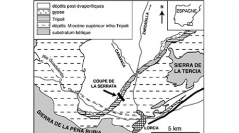

 Geodiversitas
24 (3) - Pages 543-583
Geodiversitas
24 (3) - Pages 543-583This study is a contribution to the characterisation of the palaeoceanographic changes that affected the Mediterranean at the transition from the open marine conditions which prevailed at the beginning of the Messinian to the onset of the salinity crisis, using the variations in the diatom assemblages. This biological marker was selected, as the diatomites constitute a dominant sedimentary component of this interval, classically known as Tripoli Formation. A detailed study of the diatom assemblages was carried out on three field sections selected because they represent different palaeogeographical settings: shallow basin located at the westernmost part of the Mediterranean (Lorca, Spain), deep water conditions similar to those of the central areas of the Mediterranean (Gibliscemi/Falconara, Sicily) and a marginal basin of the easternmost Mediterranean (Pissouri, Cyprus). In spite of these palaeogeographical differences, the diatom assemblages display a relative homogeneity and the large predominance of the planktonic species Thalassionema nitzschioides Grunow in Van Heurck, 1881. In the three sections, the assemblages were dominated by marine species throughout the sections up to the base of the gypsum and, in some cases, in the sediments intercalated in the lower part of the evaporites themselves. A reduction of the species diversity however was observed towards the top of the succession in Sicily and Cyprus. A major change is observed in the Falconara/Gibliscemi section where the lower part of the section is characterized by typical assemblages of colder conditions whereas assemblages indicative of warmer conditions predominate in its upper part, with some recurrences of colder influences.
Diatoms, Messinian, Mediterranean, Sicily, Spain, Cyprus